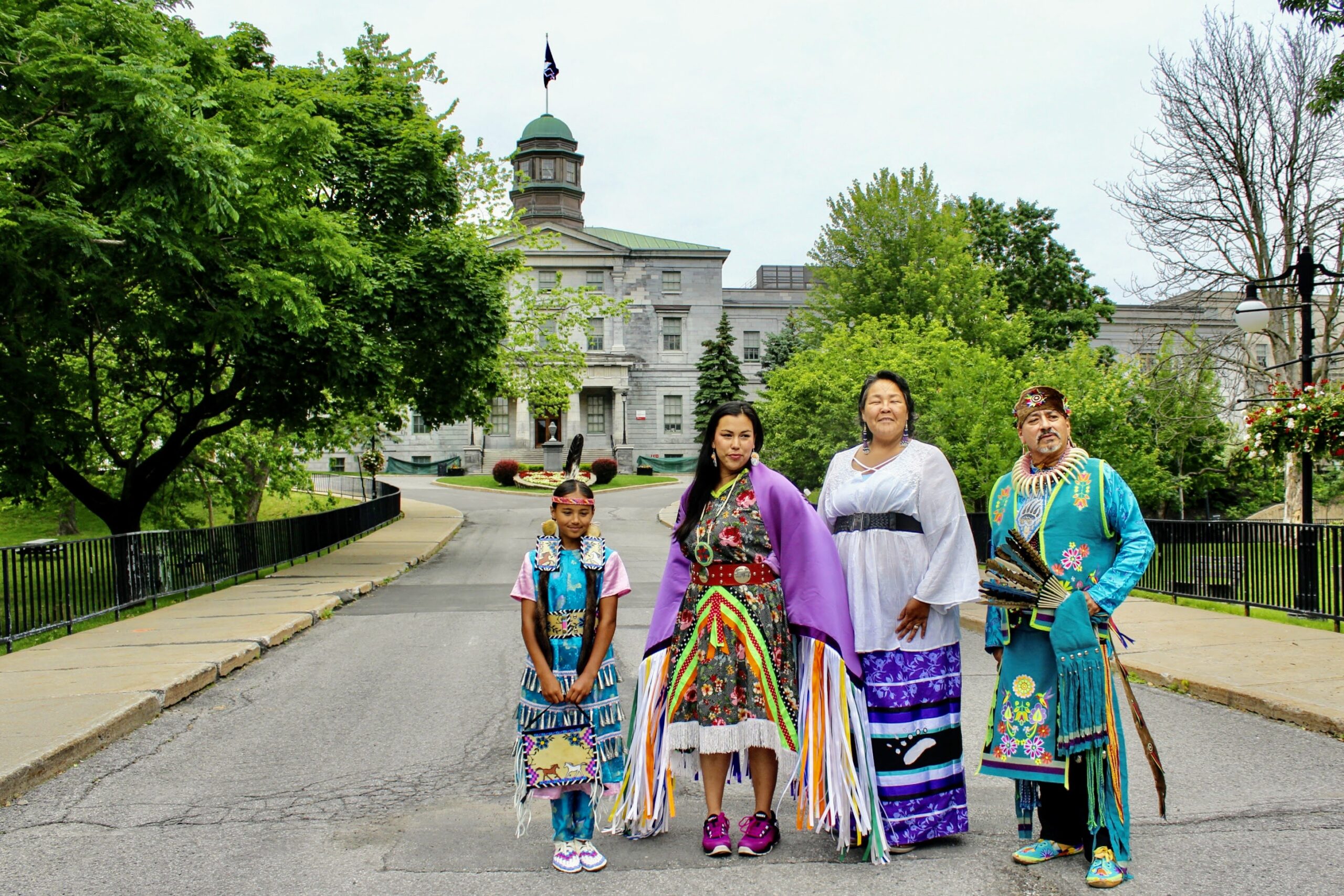
Earlier today, in honour of National Indigenous Peoples Day, McGill raised the Hiawatha Wampum Belt Flag from the McCall MacBain Arts Building. The flag will fly in its place of honour all day.
Inaugurated at McGill in 2018, the ceremony responds to one of the Calls to Action put forward by the Provost’s Task Force on Indigenous Studies and Indigenous Education in recognition of the importance of building respectful and reciprocal relations with Indigenous peoples.
Giving thanks
The ceremony began with the Opening Words of Elder Kevin Ka’nahsóhon Deer, a Faithkeeper in the Mohawk Trail Longhouse in Kahnawake. Deer spoke of the traditional thanksgiving address given by the Longhouse people.
“In our creation story this is Turtle Island, this is Mother Earth. Everything that we need for our happiness, our joy and our well-being is here in this lower world,” Deer told the audience gathered at the Y intersection. “When you look up, all the things in the upper world, all of those elements are still doing their ancient duties, rules and responsibilities. And all that is required of us, every day, is we give thanks. For us, it is expressed through ceremony, song, dance, ritual and speeches.”
“So now on behalf of everybody, we bring our minds together and we acknowledge that source of life, for all life. We’re all participating in this sacred dance,” said Deer.
Celebrating Indigenous heritage and culture
Gesturing to the purple and white flag flying from the Arts cupola, Principal Suzanne Fortier said it was “a way for us at McGill to celebrate in a symbolic way Indigenous heritage and culture… For us at McGill it is also important because it is a day for us to renew our commitment to Indigenous studies and Indigenous students.”
The Principal also acknowledged the presence of Elder Michael Loft, a retired Professor of Social Work, who led the efforts to have the flag raised above McGill. “Thank you very much for starting this great tradition,” she told a smiling Loft.
Symbolic gesture, concrete actions
“The Hiawatha Wampum Belt Flag is a symbol of peace and unity,” Provost Christopher Manfredi said in his address. “We raise it each year above our downtown campus to recognize our shared, and sometimes difficult history, to focus our awareness of the Indigenous heritage of this land, and to reflect on the path toward reconciliation and our shared commitment to Indigenous presence, representation, success and scholarship at McGill.
In 2016, Provost Manfredi stuck the Provost’s Task Force on Indigenous Studies and Indigenous Education Task Force, in response to the 2015 report of the Truth and Reconciliation Commission of Canada. The mandate of the Provost’s Task Force was to engage and collaborate with McGill and Indigenous communities to identify, explore and advance ideas and initiatives that will enhance the presence and success of Indigenous students, staff and faculty.
“Indeed, that the Hiawatha Flag flies above us today is in part the result of the very right insistence by the members of the Task Force – and the persuasive arguments of Mike Loft, as the Principal said – and the community members they consulted, that the symbolic can be as important as the concrete,” said the Provost. “It is a testament to our commitment to work together, and recognition of the efforts and aspirations of the people who are doing the heavy lifting – boldly visible, and immediate, while you work to build a better, collaborative, inclusive future.”
Making the journey together
One of the more poignant moments of the ceremony belonged to Nina Segalowitz, an Inuvialuit Throatsinger, hand drummer and spoken word artist. When she was only seven months old, Segalowitz was seized from her family through a government-led practice later called the Sixties Scoop.
Before her performance, Segalowitz addressed the crowd.
“I’m a Sixties Scoop survivor. Both my parents went to Residential School, she said. “For a long time, I felt like an imposter because I grew up in a Jewish and Filipino home. So, reconnecting with who I am was a really difficult journey. But today I stand before you a proud Innu and Dene woman… And I teach my kids and my grandkids who they are, and to be proud and to never walk in shame like my parents did, like I did when I was growing up.”
“To stand here before you is a really proud moment for me as a mother, as a grandmother. The song I’m about to share with you is the Dene Healing Song. I sing it to celebrate our healing as a people but also, as the journey goes on, our healing together,” Segalowitz said directly addressing the audience. “All of you standing here are part of our truth now. We talk about truth and reconciliation – our truth is right now standing here with you, saying our words and you listening.”
“But as you walk away, to have you carry our words with you for the rest of the time and for you to share with your families and your friends what you saw today, and what you witnessed today, that’s where our truth is going be spread and how our relationship is going to be healed.”
“This song is going to be sung in celebration of our ancestors but also of your ancestors and all the choices that they made so that you may stand here in front of us today,” said Segalowitz. “So, this is for our journey forward together with understanding and open heart.”
